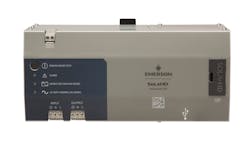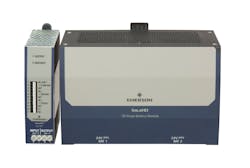Uninterruptible power supplies are common devices found in almost every enclosure to protect against outages or disruptions. The uninterruptible power supply (UPS) can vary in input or output ranges, and a fundamental choice between alternating current (ac) and direct current (dc) needs to be made.
Emerson’s UPS knowledge and offerings span the spectrum from mounting suggestions to communication options.
Q: Can you start by explaining what an uninterruptible power supply is? How does it work, and what is the state-of-the-art technology?
A UPS typically consists of three main components: a rectifier/charger, a battery bank and an inverter when an alternating-current output is required. When the main power supply is available, the rectifier converts alternating current (ac) to direct current (dc) to charge the battery. Simultaneously, the inverter converts the dc from the battery back to ac, providing a stable power output to connected devices if necessary. In the event of a power interruption, the stored energy in the battery is immediately released to maintain power to the equipment, offering crucial time for either graceful shutdown or continued operation until the main power is restored.
State-of-the-art UPS technology encompasses several advancements:
• Efficiency: Modern UPS systems incorporate high-efficiency components and advanced power management algorithms to minimize energy losses during ac-dc-ac conversions. This efficiency translates to reduced operational costs and environmental impact.
• Modularity: Modular UPS designs allow for scalability by adding or removing power modules as needed. This approach enhances reliability, as modules can be hot-swapped, ensuring uninterrupted operation during maintenance or upgrades.
• Smart monitoring and management: Advanced UPS systems offer remote monitoring and management capabilities through network interfaces. This enables real-time monitoring of power status, load levels and battery health, facilitating proactive maintenance and troubleshooting.
• Energy storage technologies: Lithium-ion batteries are gaining traction due to their higher energy density, longer lifespans and faster recharge times compared to traditional lead-acid batteries. These batteries enhance UPS efficiency and reduce the physical footprint.
These advancements collectively contribute to UPS systems that offer higher reliability, better energy efficiency and improved management capabilities, making them an essential component in ensuring the seamless operation of critical electronic equipment.
Q: What sort of input and output ranges can be expected from various UPS offerings?
A: Uninterruptible power supplies come in various types, each with distinct input and output voltage ranges tailored to diverse applications. Offline/standby UPS typically offers input ranges around ±15% of nominal voltage (120-220 Vac, 24 Vdc), ensuring power continuity during minor fluctuations. Line-interactive UPS maintains a similar input range, safeguarding against voltage variations. Online/double-conversion UPS provides a wider input range of around ±25% or more, guaranteeing consistent output by continuously converting incoming power.
The choice between ac and dc UPS hinges on equipment nature, efficiency, battery voltage, redundancy, maintenance and cost considerations. AC UPS is efficient for long-distance distribution, while DC UPS is suitable for direct power transmission. AC UPS is more available and cost-effective due to wider use. Hybrid solutions can convert ac to dc or vice versa based on equipment requirements. To select the right UPS, assess equipment needs, consult experts and balance factors like efficiency, compatibility and budget.
Q: How do I decide to utilize an AC UPS or a DC UPS?
A: Deciding between AC UPS and DC UPS depends on your specific application and power requirements. Choose an AC UPS if your critical equipment primarily operates on ac power, such as computers, servers and appliances. AC UPS systems are widely available and compatible with standard power sources. Opt for a DC UPS if your equipment relies on dc power, commonly seen in industrial machinery and specific electronics. DC UPS systems can avoid unnecessary ac-to-dc conversion, increasing efficiency. Consider AC UPS for its broader support, simplicity and easy integration, while DC UPS suits dc-dependent applications for minimal conversion loss. Ultimately, your choice should align with your equipment's power needs, efficiency goals and compatibility with existing systems.
Q: Data gathering continues to grow in importance. How can UPS data be used by manufacturers?
A: Manufacturers can leverage UPS data for operational optimization and predictive maintenance. Real-time UPS data, including input/output voltages, load levels and battery status, provides insights into power quality and equipment health. Manufacturers can identify voltage irregularities affecting machinery performance and take corrective actions. Load monitoring helps balance energy distribution, optimizing resource allocation. Battery data aids in predicting battery failures and preventing downtime.
UPS data can enhance overall supply-chain efficiency. Manufacturers can track power disruptions and downtime occurrences, enabling proactive communication with customers and suppliers. Analyzing historical UPS data helps identify patterns and trends, guiding strategic decisions for capacity planning and load balancing. Ultimately, utilizing UPS data enables manufacturers to enhance production efficiency, minimize downtime, improve product quality and strengthen customer relationships.
Uninterruptible power supplies can also provide an automated shutdown process for connected equipment including industrial PCs, computers, and programmable logic controllers (PLCs) via their communication connections. This feature helps customers to safely shut down their critical equipment after the line power has failed. This helps to ensure data integrity and improve overall startup functions.
Q: What sort of communication protocols are necessary for connecting uninterruptible power supplies?
A: There are a host of protocols available from most suppliers depending on your need and application. The most popular these days are those that utilize industrial Ethernet such as Ethernet/IP, Modbus TCP, PROFINET and EtherCAT. Many legacy protocols are available as well for communicating over twisted-pair communication networks.
The industrial communication protocol selection is also dependent on the existing network and potential control systems in place. Most control-system platforms have preferred compatible communication networks which allow for seamless integration of devices including uninterruptible power supplies. Users prefer simple integration of the product and common interfaces.
Q: What mounting or footprint considerations need to be made, given the premium on cabinet space?
A: There are various mounting options, depending on the application. These include shelf, back plane and DIN rail mount, rack mount and free standing. For a control enclosure, DIN rail is preferred. Some suppliers will give an option to mount the battery external to the control enclosure to save space. The backup time specification is also critical when it comes to space constraints for UPS; the more backup time needed means the more batteries that are needed. Therefore, the upfront design of the overall electrical system is critical when it comes to cabinet design constraints.
Q: Why should main control power go through an uninterruptible power supply?
A: Routing main control power through an uninterruptible power supply is crucial to maintain uninterrupted operations of critical systems. A UPS safeguards against power interruptions, providing continuous power during outages. This ensures seamless functionality, prevents data loss and protects equipment from potential damage caused by voltage fluctuations. In industries like manufacturing, healthcare and finance, where downtime can lead to significant losses or regulatory non-compliance, a UPS serves as a vital contingency measure. It guarantees data integrity, supports safe shutdown procedures and maintains stable power, ultimately enhancing system reliability and minimizing risks associated with power disruptions.
Q: How did the UPS replace devices like power filters, capacitive filters, metal oxide varistors, coil suppression and free-wheeling diodes on dc coils?
A: Uninterruptible power supplies have not replaced the specific devices like power filters, capacitive filters, metal oxide varistors (MOVs), coil suppression and free-wheeling diodes used for various purposes in electrical circuits, especially those involving dc coils. Instead, UPS systems serve a different primary purpose: providing backup power during electrical outages or fluctuations.
Power filters, capacitive filters, MOVs, coil suppression and free-wheeling diodes are components designed to mitigate issues like noise, voltage spikes and inductive kickback in specific applications. They are integral to circuit protection and performance enhancement, addressing distinct electrical challenges.
UPS, on the other hand, ensures continuity of power to critical devices by providing a temporary power source during disruptions. While advanced UPS models might incorporate basic surge protection or filtering components, their primary focus is not to replace the functions of these components but rather to offer a stable power source during outages.
When dealing with specific electrical issues like noise or voltage spikes, it's important to use appropriate components like filters and suppression devices. Integrating these with a UPS system can provide comprehensive protection and backup power, ensuring both reliable power delivery and proper circuit protection.
For more information, visit www.emerson.com/en-us/automation/solahd/.



